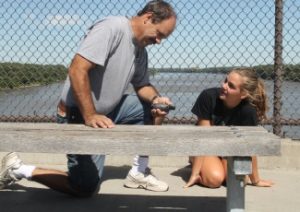 It’s a hot, humid day, and senior Katie Hamman and her dad Kerry Hamman are on the Katy Trail, searching for a hidden item. Surrounded by trees, Katie leads the way down a gravel covered path, following the directions of a handheld GPS.
It’s a hot, humid day, and senior Katie Hamman and her dad Kerry Hamman are on the Katy Trail, searching for a hidden item. Surrounded by trees, Katie leads the way down a gravel covered path, following the directions of a handheld GPS.
Following their GPS, Katie and Kerry notice two benches up ahead. Walking up to a wooden gate located behind the benches, Katie reaches for something. She pulls out a black container and opens it. Inside she finds cards, a lost dog poster, a small Power Ranger action figure, a bicycle reflector, some temporary tattoos, toy cars, a Spider-Man action figure and a small notebook full of dates and people’s signatures. She flips through the notebook and signs her own name to the list.
Katie and Kerry are geocaching.
Geocaching made its debut in 2000. It is an activity where participants use a GPS to hide and seek containers called caches, which are usually small waterproof containers that contain a logbook and knickknacks left by other geocachers. After finding a cache, geocachers can take out a knickknack and replaces it with something else. There are also traveling items called Travel Bugs in some caches. These are items that can be tracked on Geocaching.com.
Katie discovered geocaching during her junior year through her through he dad. Kerry who is fire captain for the city of St. Charles, was introduced to geocaching by his son after the two of them started using handheld GPS on a search and rescue team.
“I got interested in it because of my rescue work,” Kerry said, “And I asked Katie to go because it was something we could go out and do together.”
Although she was a little skeptical of it at first, Katie agreed to go geocahcing. After finding her first cache, Katie started to enjoy geocaching because it gives her a chance to get out of the house and bond with her dad.
“It’s a way to get outside and exercise,”Katie said. “You get to explore and find different things.”
Former FHN teacher Ron Ochu also enjoys geocaching. Ochu discovered geocaching through HAM radio, a type of communication that uses radio frequencies, allowing you to talk to people all around the world. Ochu says that geocaching has led him to discover many interesting places.
“I think [the best thing about geocaching] is finding these unusual places that are just so full of history,” Ochu said. “I see things that I normally wouldn’t see.”
According to Geocaching.com, there are more than one thousand geocaches located throughout the St. Charles County area. Each one is unique and distinguished by name. The cache found by Katie and Kerry is called Sit a Spell. It is located along the Katy Trail in St. Charles near the Page extension bridge.
After putting the items back into the container, Katie tucks it back behind the gate, leaving its treasures for another geocacher to discover. For Katie and Kerry, the mystery behind the contents of a cache makes geocahing worthwhile.
“It’s always the unknown, you know?” Kerry said. “First you’ve got to find [the cache] and see what’s in it. Is it just a log or more stuff? It’s like a big treasure hunt.”
Story By Amanda Satllings










